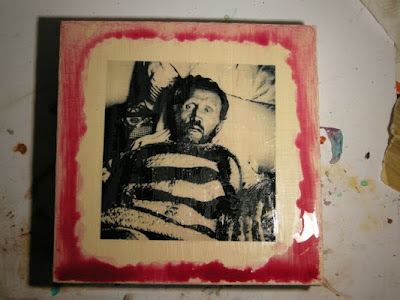This photo of Father Damien was taken within a two weeks of his death. The photo was taken by William Brigham. Father Damien's right arm is in a sling made by Mother Marianne from a red silk scarf.
"Look at my hands, all the wounds are healing and the crust is becoming black...I have seen so many lepers die, that I cannot be mistaken. Death is not far off. I have seen visions of the good God calling me to celebrate Easter with Him. May God be blessed for it. " Father Damien, 1889. This quote is taken from the book, "The Lands of Father Damien" by James E. Broker.
This is an ink jet print that I am hand coloring and adding back the detail that is lost by way of the fact that this is a second or third generation print of an image whose exposure wasn't the best, let alone the quality and sharpness of it.
A detail of his hand that I had 'touched up'. Because I still have to make a laser color copy of this image and do a gel transfer from it, I leave the image in an exaggerated state that you see here. Most of the touch up work is done with Berol Prismacolor colored pencils (brand name of the pencil).
In making a decision as to which image to choose to represent him in "The Saint", I chose this one because it shows him in the advanced stages of leprosy; a state that he had seen in the residents of the Kalaupapa peninsula every day for 16 years. An important part of the decision is to NOT visually lessen the appearance of the disease. When I began this project, the selection of images via Google in regards to leprosy was not nearly as much as there is at this writing. Interesting, huh? Last night I noted that there was so many more images of people afflicted with leprosy. I'm sure the impending canonization date has a lot to do with it.
Here, the canvas is being prepared with the background color.
Making sure that I am satisfied with the gel skin before I adhere it to the canvas.
And, a snippet of the final image.
To become a saint, three miracles have to be documented as an intercession of an illness. To find out what the third miracle was click here for the video clip that explains what that miracle was.
Of course, if you want to see the images from this series in its entirety, please be sure to come to the exhibition for the show. Click here to view the flyer for the show. I am also in the process of creating a site dedicated to this Damien Series. Check back to it for updates for a possible one month exhibition and for more detailed information that will be added for each of these 'paintings'. I will be going home in January and plan to make a pilgrimage to the peninsula, God willing. Here's the link for the blog: www.damienofmolokai.blogspot.com.




































